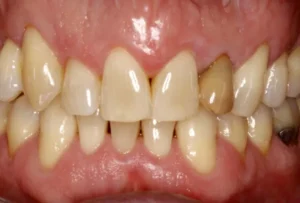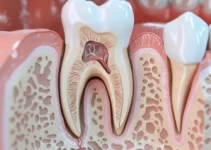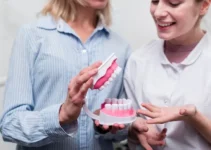Crooked teeth aren’t just a cosmetic concern; they can also affect oral health and functionality. This common dental issue can result from genetic factors, poor dental habits in childhood such as thumb sucking, or significant discrepancies in jaw size. Misalignments might lead to harder-to-clean surfaces, increasing the risk of gum disease and tooth decay. Various treatment options exist, from traditional braces to modern clear aligners, each tailored to specific needs and lifestyles. Learn more about the underlying causes of crooked teeth and the effective solutions available to achieve a healthier, straighter smile.
Causes of Crooked Teeth
The alignment of our teeth is influenced by a range of factors. While some causes of crooked teeth are beyond our control, others are the result of habits or incidents that occur during our lifetime. Understanding the root causes can help in mitigating or preventing the misalignment. Here, we delve into three primary causes: genetic factors, poor oral habits, and injury or trauma.
By recognizing these causes, it becomes easier to identify preventive measures and solutions. Although not all cases of crooked teeth can be avoided, early detection and intervention can reduce the severity of the issue. Let’s explore each cause in more detail to understand their impact and the potential methods of addressing them.
Genetic Factors
Genetics play a significant role in determining the alignment of our teeth. If one or both parents had crooked teeth, there is a higher likelihood that their children will inherit the same trait. This is because genetic factors influence the size and shape of the jaw, which in turn impacts how the teeth are arranged.
Some genetic conditions may also result in misaligned teeth. Conditions such as cleft lip and palate can lead to severe dental misalignments that require early and comprehensive orthodontic treatment.
Other hereditary aspects, such as having an overbite, underbite, or overcrowded teeth, can be attributed to the genetic blueprint passed down from one generation to the next. The oral health history of one’s family can offer significant insights into potential orthodontic needs.
It is essential to note that while genetic factors are beyond our control, being aware of them can prompt early orthodontic consultations, which can minimize the impact of these inherited traits.
Poor Oral Habits
Certain oral habits, if practiced during childhood, can lead to the misalignment of teeth. Thumb sucking, prolonged use of a pacifier, and bottle-feeding beyond the infant years are examples of habits that exert pressure on the developing teeth and jaw. Over time, this pressure can result in crooked teeth.
Another poor oral habit is improper swallowing or tongue thrusting, where the tongue pushes against the teeth when swallowing. This can cause the teeth to move out of their natural alignment. Such habits need to be corrected early on to prevent long-term impact on dental alignment.
Poor oral hygiene and neglect can also indirectly contribute to crooked teeth. Tooth decay and gum disease can lead to the loss of primary teeth prematurely, affecting the alignment of the permanent teeth that follow. Ensuring proper dental care practices from a young age is vital in maintaining proper dental arrangement.
Maintaining good oral hygiene and addressing bad habits early can significantly reduce the risk of developing crooked teeth due to these factors.
Injury or Trauma
Accidents and injuries affecting the mouth or jaw can also lead to the misalignment of teeth. Trauma to the facial region can alter the position of the teeth and the way they grow, leading to crooked teeth. It’s crucial to address and treat such injuries promptly to prevent lasting effects on dental alignment.
In some cases, injuries may cause tooth loss, resulting in gaps. These gaps can cause the remaining teeth to shift toward the empty space, leading to misaligned teeth. Immediate dental intervention can help to restore the normal alignment and prevent further complications.
Sports-related activities without the use of mouth guards are a common cause of dental injuries. Athletes, especially children, should be encouraged to wear protective gear to safeguard their teeth against trauma.
Understanding how injury or trauma can impact dental alignment emphasizes the importance of taking preventive measures and seeking timely dental care when injuries occur.
Understanding the causes of crooked teeth is crucial in taking proactive steps to maintain good oral health. Learn more about this and other dental topics in our subsequent articles.
Potential Health Issues from Crooked Teeth
Crooked teeth are not just an aesthetic issue; they can also lead to a range of health problems if left untreated. Misaligned teeth can create difficulties in maintaining adequate oral hygiene, which often paves the way for more serious dental complications. By understanding these potential issues, individuals can be better prepared to seek timely orthodontic treatment.
When teeth are not properly aligned, it becomes challenging to clean all surface areas effectively. This inadequate cleaning can serve as a breeding ground for bacteria, significantly raising the risk of oral health issues. Below, we will delve into three of the most common health issues arising from crooked teeth: gum disease, tooth decay, and difficulty chewing.
Gum Disease
One of the primary concerns with crooked teeth is the increased risk of gum disease, also known as periodontal disease. This condition is caused by the build-up of plaque—a sticky film of bacteria that forms on teeth. When teeth are misaligned, it is very challenging to remove plaque effectively, resulting in inflammation of the gums or gingivitis.
If left untreated, gingivitis can progress to periodontitis, a more severe form of gum disease that can lead to tooth loss. Studies have shown that individuals with misaligned teeth are more susceptible to periodontal disease due to the difficulty in maintaining proper oral hygiene.
To mitigate the risks, it is crucial to seek orthodontic treatment, such as braces or aligners, to correct the alignment of your teeth. Proper alignment not only enhances the appearance of your smile but also facilitates easier cleaning, thereby reducing the risk of gum disease.
Tooth Decay
Crooked teeth can also contribute to increased instances of tooth decay. Just as misaligned teeth can hinder effective plaque removal, they also create hard-to-reach areas that are particularly susceptible to cavities. Tooth decay occurs when the acids produced by bacteria in plaque erode the enamel, leading to the formation of holes or cavities in the teeth.
Several factors contribute to the heightened risk of tooth decay in individuals with crooked teeth:
- Ineffective brushing
- Flossing challenges
- Increased plaque accumulation
Regular dental check-ups and cleanings are essential for anyone, but they are even more crucial for those with misaligned teeth. In addition to professional cleanings, using specialized cleaning tools such as interdental brushes and water flossers can help manage plaque build-up.
Difficulty Chewing
Another significant issue associated with crooked teeth is difficulty chewing. When teeth are misaligned, it can lead to an uneven bite, making it challenging to chew food properly. This can result in various digestive problems since proper mastication is the first step to effective digestion.
Difficulty chewing can lead to a range of issues, including:
- Inadequate nutrient absorption
- Stomach problems
- Jaw pain or temporomandibular joint (TMJ) disorders
Orthodontic treatments not only improve the alignment of teeth but also facilitate a more balanced bite, making chewing more efficient and less painful. Enhanced chewing ability ensures better digestion and overall health.
Understanding the potential health complications arising from crooked teeth can motivate individuals to seek orthodontic solutions. By addressing these issues early, you can not only improve your oral health but also enhance your overall well-being. For more insights into dental care and treatments, don’t forget to explore our other articles.
Orthodontic Solutions for Crooked Teeth
Dealing with crooked teeth is a common dental issue that affects not only the appearance of your smile but also your overall oral health. Fortunately, modern orthodontics offers a variety of solutions to address this problem effectively. Two of the most popular options are traditional braces and Invisalign. Both methods aim to align the teeth properly, but they come with different features and benefits.
Choosing the right orthodontic solution depends on various factors, including the severity of the misalignment, your age, and personal preferences. Consulting with an orthodontic specialist can help you determine the best treatment plan tailored to your specific needs. Understanding the differences between braces and Invisalign can make the decision-making process easier.
Let’s explore both braces and Invisalign in detail to understand how each method works and what advantages they offer.
Braces
Traditional braces are among the most effective and time-tested solutions for correcting crooked teeth and bite issues. They consist of metal brackets bonded to the teeth, connected by wires and elastic bands. The orthodontist periodically adjusts these components to gradually move the teeth into the desired positions. Braces are particularly effective for treating complex dental issues such as severe overcrowding, gaps, and significant bite misalignments. The treatment duration can vary, typically ranging from 18 months to three years, depending on the complexity of the case.
One of the significant advantages of braces is their ability to provide precise control over tooth movement. Because they are not removable, they ensure continuous pressure on the teeth, leading to efficient and predictable outcomes. They are also ideal for younger patients whose teeth and jaws are still developing.
Despite their effectiveness, braces do come with some drawbacks. They are highly visible and can be uncomfortable, especially during the initial adjustment periods. Additionally, maintaining oral hygiene requires more effort to prevent plaque buildup around the brackets and wires.
Invisalign
Invisalign offers a modern and discreet alternative to traditional braces. This system uses a series of custom-made, transparent aligners that fit snugly over the teeth. Each set of aligners is worn for about two weeks before being replaced by the next set in the series, gradually shifting the teeth into place.
One of the primary benefits of Invisalign is its virtually invisible appearance, making it an attractive option for adults and teenagers who are conscious about their appearance during treatment. The aligners are also removable, allowing you to eat, drink, and maintain your oral hygiene without restrictions. Invisalign is most effective for mild to moderate orthodontic issues, such as minor crowding, gaps, and simple bite irregularities. Treatment time varies but generally ranges from 6 to 18 months. Regular check-ups with the orthodontist are necessary to monitor progress and make any necessary adjustments.
However, Invisalign does have limitations. It may not be suitable for more complex dental issues that require significant tooth movement or bite correction. Additionally, the success of the treatment relies heavily on patient compliance, as the aligners need to be worn for 20-22 hours a day to achieve the desired results.
Both braces and Invisalign are effective orthodontic solutions for crooked teeth, each with its own set of advantages and challenges. By thoroughly understanding these options and consulting with an orthodontist, you can make an informed decision that best suits your needs and lifestyle. For more in-depth information on other dental treatments, be sure to explore our other articles.
FAQ on Crooked Teeth
If you are seeking more clarity on the causes and solutions for crooked teeth, the following FAQs might help you find the answers you need.
What are the common causes of crooked teeth?
Crooked teeth can stem from various factors including genetics, which means they can be inherited from parents. Poor dental habits during childhood, like thumb sucking, prolonged use of a pacifier, or incorrect swallowing reflexes can also play a role. Moreover, inadequate nutrition or premature loss of baby teeth, which shift the space for adult teeth, can contribute to misalignment.
What are some effective treatments for crooked teeth?
The most common treatment for crooked teeth is orthodontics, including braces and clear aligners such as Invisalign. These devices help in gradually shifting the teeth into their correct position. For mild cases, veneers or contouring can also be considered. Advanced misalignments might require surgical interventions for optimal corrections. It’s essential to consult with a dental specialist to choose the right treatment plan based on the severity of the condition.

My name is Salman Kapa, a 73-year-old expert in bone regeneration and dental implantology. With decades of experience in the field, I am dedicated to advancing our understanding of oral health and hygiene. Through my research and writing, I aim to contribute to the development of innovative solutions in dental care.




